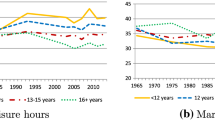Abstract
Leisure came into economic analysis by the back door. Even Veblen, in whose primary title (1899) leisure had the primary place, was not much interested in it except insofar as leisure embodied the idleness and waste of resources in ‘pecuniary emulation’ that were the motive and the trophy of the moneyed class. In the subsequent and more serious analytical business of sorting out the response of labour supply to changing real wages begun by Knight (1921) and Pigou (1920) and continued by Robbins (1930), leisure was introduced but only as a residual; the time left over when time spent working had been accounted for. Leisure became a consumption good. It needed only simple characteristics; to be sufficiently (if vaguely) pleasing that, when set against income, as all other consumption goods, it would generate a nicely behaved indifference curve in time-income space and hence a determinate allocation of time to work.
Access this chapter
Tax calculation will be finalised at checkout
Purchases are for personal use only
Preview
Unable to display preview. Download preview PDF.
Similar content being viewed by others
Bibliography
Becker, G. 1965. A theory of the allocation of time. Economic Journal 75, September, 493–517.
Knight, F. 1921. Risk, Uncertainty and Profit. Chicago: University of Chicago Press, 1971.
Linder, S. 1970. The Harried Leisure Class. New York: Columbia University Press.
Pigou, A. 1920. The Economics of Welfare. London: Macmillan; 4th edn, New York: Macmillan, 1938.
Quarterly Journal of Economics. 1973. Symposium: Time in economic life. Quarterly Journal of Economics 87(4), November, 627–75.
Robbins, L. 1930. On the elasticity of demand for income in terms of effort. Economica 10, June, 123–9.
Time Magazine. 1969. Leisure. August.
Veblen, T. 1899. The Theory of the Leisure Class: An Economic Study of Institutions. New York: New American Library, 1953.
Winston, G. 1982. The Timing of Economic Activities: Firms, Households, and Markets in Time-Specific Analysis. New York: Cambridge University Press.
Editor information
Copyright information
© 1991 Palgrave Macmillan, a division of Macmillan Publishers Limited
About this chapter
Cite this chapter
Winston, G.C. (1991). Leisure. In: Eatwell, J., Milgate, M., Newman, P. (eds) The World of Economics. The New Palgrave. Palgrave Macmillan, London. https://doi.org/10.1007/978-1-349-21315-3_48
Download citation
DOI: https://doi.org/10.1007/978-1-349-21315-3_48
Publisher Name: Palgrave Macmillan, London
Print ISBN: 978-0-333-55177-6
Online ISBN: 978-1-349-21315-3
eBook Packages: Palgrave Economics & Finance CollectionEconomics and Finance (R0)




